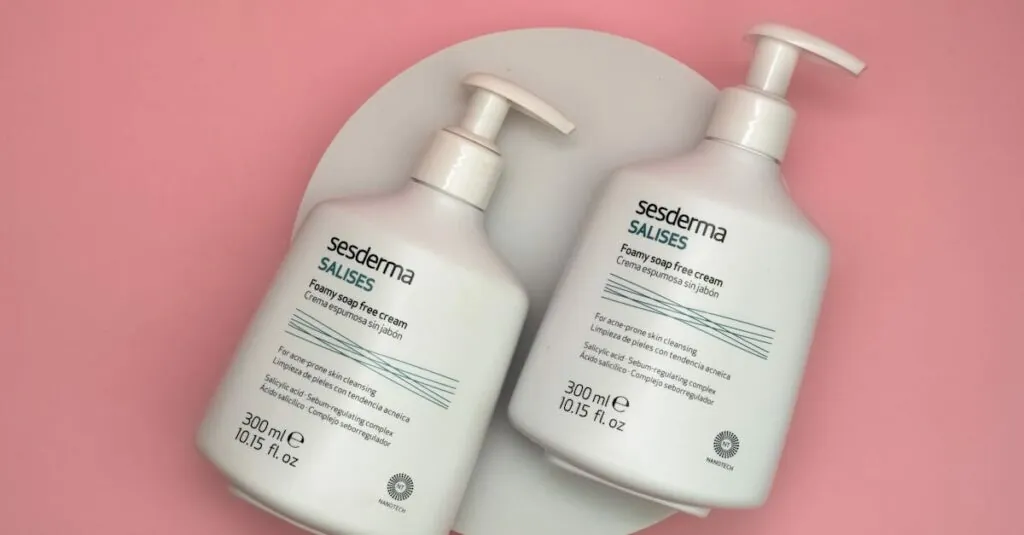Table of Contents
ToggleHyperpigmentation can feel like that uninvited guest who overstays their welcome. Whether it’s dark spots from sun exposure or pesky post-acne marks, everyone wants to kick those blemishes to the curb. Luckily, the beauty industry has stepped up with a dazzling array of hyperpigmentation products that promise to lighten, brighten, and even out skin tone.
Overview Of Hyperpigmentation
Hyperpigmentation appears as dark spots on the skin, often resulting from excessive sun exposure, hormonal changes, or post-inflammatory processes. It affects individuals of all skin types and ages. Increased melanin production causes these areas of discoloration, leading to uneven skin tones. Sunspots and melasma rank among the most common forms of hyperpigmentation.
In a search for treatment options, many consumers find an overwhelming array of products promising to lighten and brighten affected areas. Ingredients like hydroquinone, vitamin C, and licorice extract frequently emerge in formulations aimed at reducing pigmentation. These components contribute to melanin inhibition and promote an even skin tone.
Various treatments exist beyond topical products. Chemical peels, laser therapies, and microdermabrasion represent alternative approaches. Each method works differently, targeting skin texture and color through specific processes.
Understanding the underlying causes remains essential for selecting the right hyperpigmentation product. Medications or supplements that address hormonal imbalances may help in some cases. Consulting a dermatologist aids in determining the most effective strategies for individual skin conditions.
Anticipating results is crucial; improvement may take several weeks or even months. Regular use of sunscreen plays a vital role in prevention, helping to protect skin from further damage. Adopting a consistent skincare routine enhances treatment efficacy and promotes overall skin health.
An informed approach not only elevates expectations but also strengthens the commitment to achieving a brighter, more even complexion.
Common Causes Of Hyperpigmentation
Hyperpigmentation arises from various factors, which include sun exposure and hormonal changes. Understanding these causes aids in selecting effective treatment options.
Sun Exposure
Sun exposure stands out as a primary cause of hyperpigmentation. Ultraviolet (UV) rays stimulate melanin production, leading to dark spots on the skin. Individuals often notice these sunspots appearing on areas like the face, shoulders, and back. Protection against UV damage relies on consistent sunscreen application, even on cloudy days. Many products specifically designed to target sun-induced discoloration incorporate ingredients that help inhibit melanin synthesis. Regular use of sunscreen with a minimum SPF of 30 significantly reduces the risk of developing new spots.
Hormonal Changes
Hormonal changes frequently contribute to hyperpigmentation, particularly in women. Pregnancy, menstruation, or conditions like polycystic ovary syndrome (PCOS) can trigger melasma, a specific type of pigmentation. Fluctuations in hormone levels often lead to dark patches, especially on the face. Many individuals experience these changes during oral contraceptive use or hormone replacement therapies as well. Targeting this type of hyperpigmentation often involves a combination approach, including topical treatments and lifestyle changes. Consulting a dermatologist proves beneficial in creating a tailored plan to address hormonal influences on skin tone.
Types Of Hyperpigmentation Products
Various products target hyperpigmentation, each designed to address specific causes effectively. Understanding these options helps consumers choose the right solutions for their skincare needs.
Creams And Serums
Creams and serums serve as popular choices for lightening dark spots. They often contain potent ingredients like hydroquinone, a well-known skin-lightening agent, and vitamin C, which brightens the complexion while providing antioxidant protection. Niacinamide also appears frequently in these formulations, reducing inflammation and improving skin texture. Users often apply these products daily for visible results; consistency plays a crucial role in achieving a more even skin tone.
Peels And Treatments
Peels and treatments offer deeper solutions for stubborn hyperpigmentation. Chemical peels typically use ingredients like glycolic acid and salicylic acid to exfoliate the skin while targeting pigmentation issues. These treatments promote cell turnover, revealing fresher skin underneath. Laser treatments represent another effective avenue, targeting discoloration through focused light energy. Professionals usually perform these procedures, ensuring optimal safety and effectiveness. Results often appear gradually, with multiple sessions necessary for significant improvement.
Key Ingredients To Look For
Selecting hyperpigmentation products requires knowledge of key ingredients. The effectiveness of these ingredients plays a crucial role in achieving an even skin tone.
Vitamin C
Vitamin C delivers antioxidant protection and inhibits melanin production. This ingredient brightens dark spots and provides a uniform complexion. Users often find that serums with stable forms of Vitamin C, such as ascorbic acid or sodium ascorbyl phosphate, yield the best results. Regular application boosts skin radiance and diminishes the appearance of blemishes. Studies indicate that incorporating Vitamin C into a skincare routine leads to noticeable improvements in pigmentation and overall skin tone.
Hydroquinone
Hydroquinone stands out as a powerful skin-lightening agent that targets hyperpigmentation directly. It reduces melanin synthesis, leading to a more balanced skin tone. Many dermatologists recommend this ingredient for persistent dark spots caused by sun exposure or acne scars. Users should note that formulations with 2% hydroquinone are common over the counter, while stronger versions require a prescription. Consistent application is essential for seeing desired results, while some may experience short-term irritation. Observing the skin’s response and consulting a dermatologist ensures safe and effective use.
How To Choose The Right Product
Understanding how to select the right hyperpigmentation product requires knowledge of key ingredients. Prioritize products containing vitamin C, which offers antioxidant benefits and inhibits melanin production. Hydroquinone ranks as a powerful agent for lightening skin, making it a recommended option for persistent dark spots.
Consider skin type before making a choice. Oily skin may benefit from lightweight serums, while dry skin might require richer creams for optimum hydration. Different formulations target specific issues, so identifying individual needs enhances effectiveness.
Read product labels and look for ingredients like licorice extract. This natural compound soothes inflammation and further reduces pigmentation. Niacinamide also plays a significant role in evening skin tone and improving overall texture.
Think about how often the product must be applied. Some treatments require daily use to achieve visible results, while others may be more effective with less frequent application. The commitment to a consistent routine is essential for long-term improvements.
Seek professional guidance when uncertain about which product suits specific skin concerns. Dermatologists can provide tailored recommendations based on individual conditions, ensuring safety and effectiveness.
Examine reviews and feedback from others who have tried the products. Positive testimonials often indicate a product’s efficacy, while negative ones serve as cautionary tales. Gathering insights helps build a well-informed decision.
Above all, be patient. Results take time, with noticeable changes often emerging after several weeks or months. Regular sunscreen use remains crucial in preventing further pigmentation and supporting overall skin health during treatment.
Tips For Best Results
Aim for consistency in application. Products targeting hyperpigmentation require regular use to achieve desired results. Apply creams and serums daily, ensuring an even layer covers affected areas.
Select products containing effective ingredients. Hydroquinone, vitamin C, and licorice extract offer proven benefits in lightening dark spots. Products with niacinamide can also enhance their efficacy, making skin tone look more uniform.
Incorporate sunscreen into your skincare routine. Sun protection is essential in preventing further pigmentation, even on cloudy days. Look for a broad-spectrum sunscreen with SPF 30 or higher for adequate protection against UVA and UVB rays.
Consult a dermatologist for personalized advice. Professional guidance helps tailor treatments to individual skin types and conditions. Dermatologists can recommend suitable products and procedures based on specific needs.
Monitor skin’s response to treatments. Noting any changes helps evaluate product effectiveness and ensures adjustments can be made if necessary. If irritation occurs, consider reducing application frequency or switching products.
Stay patient throughout the process. Improvements in hyperpigmentation often take time, ranging from weeks to months. Maintaining a consistent routine and following expert advice enhances the likelihood of achieving a brighter complexion.
Navigating the world of hyperpigmentation products can feel overwhelming but understanding the right ingredients and treatments can make a significant difference. Consistency is vital in any skincare routine aimed at achieving a more even skin tone. With options ranging from topical treatments to professional procedures, individuals can find solutions tailored to their specific needs.
Staying informed about the causes of hyperpigmentation and the benefits of key ingredients like vitamin C and hydroquinone empowers consumers to make educated choices. Regular consultations with dermatologists can enhance treatment efficacy and ensure safety. With patience and dedication, it’s possible to diminish dark spots and embrace a brighter, healthier complexion.







